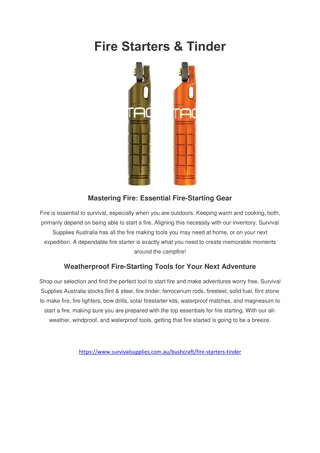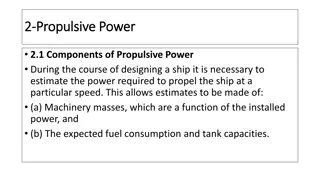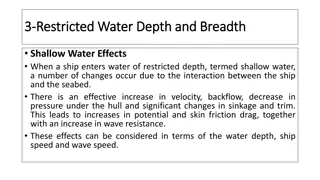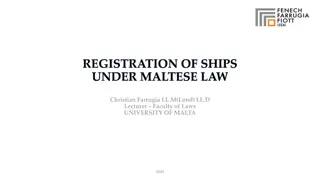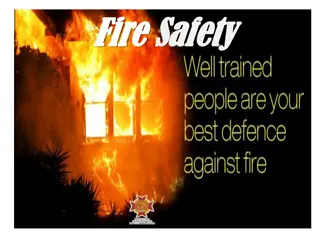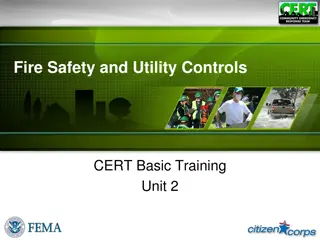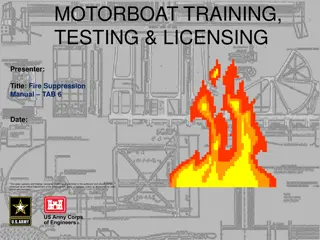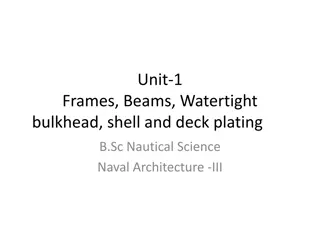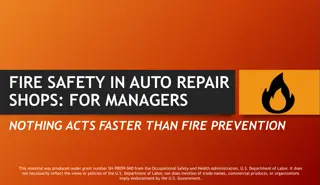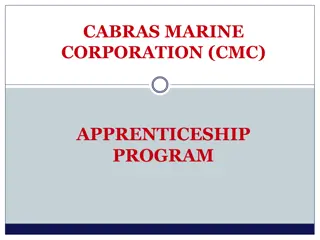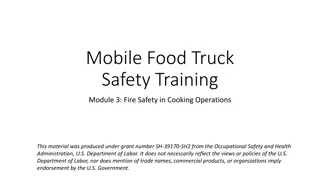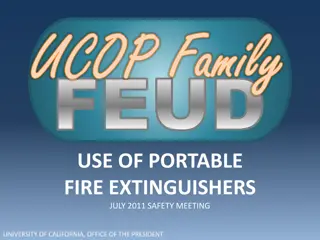Fire Fighting on Board Ship: Prevention and Response Measures
A fire on a ship is a highly dangerous incident, and prompt detection is crucial to prevent extensive damage. Crews need to act swiftly, utilizing fire hoses and breathing protection. Professional assistance may be required if the fire has escalated. Shipboard fires are a significant threat, with common causes including maintenance issues, welding, smoking, and electrical faults. Proper fire-fighting procedures, including detection, alarm, and control, are essential for safety at sea.
Download Presentation

Please find below an Image/Link to download the presentation.
The content on the website is provided AS IS for your information and personal use only. It may not be sold, licensed, or shared on other websites without obtaining consent from the author.If you encounter any issues during the download, it is possible that the publisher has removed the file from their server.
You are allowed to download the files provided on this website for personal or commercial use, subject to the condition that they are used lawfully. All files are the property of their respective owners.
The content on the website is provided AS IS for your information and personal use only. It may not be sold, licensed, or shared on other websites without obtaining consent from the author.
E N D
Presentation Transcript
20 Fire on Board Part I. FIRE FIGHTING ON BOARD SHIP I
A fire on a ship is one of the most dangerous incidents which can happen on board. If the fire is detected in good time, the crew can prevent larger damages by taking immediate measures such as fighting the fire by use of a fire hose under breathing protection. If the fire has already spread, professional aid is absolutely needed, which can be rendered via helicopter or by ship.
Multiple Choice Test A fire on a ship is one of the most dangerous incidents which can happen on broad/board/breadth. If the fire is covered/found/detected in good time, the crew can prevent larger damages by taking immediate measures such as fighting the fire by use of a fire nose/host/hose under breathing protection. If the fire has already sprung/spread/sparkled, professional aid is absolutely needed, which can be rendered via helicopter or by ship.
Every year more and more ships are lost through fire and collision. Shipboard fire alone, however, results in more total losses of ships than any other form of casualty. The most common causes of shipboard fire are the most obvious: maintenance burning and welding are responsible for nearly 40 per cent of all outbreaks. Smoking leads to countless fires that break out when no one expects. Lack of attention, spontaneous combustion and electrical faults are the major causes. The engine room is at special risk from flashbacks in oilfired boilers, leaky pipings carrying oil, overheated bearings and even the accumulation of rubbish (oil rags, dirty oil, tins of oil, etc.). Fire fighting at sea includes three distinct stages: detection, - locating the fire; alarm- informing the rest of the ship; control actuating the means of extinguishing the fire.
Supply the missing term Every year more and more ships are lost through ______ and collision. Shipboard fire alone, however, results in more total losses of ships than any other form of ______. The most common causes of shipboard fire are the most obvious: maintenance ______ and welding are responsible for nearly 40 per cent of all ______. Smoking leads to countless fires that break ______ when no one expects. Lack of attention, spontaneous combustion and electrical ______ are the major causes. The engine room is at special risk from ______ in oilfired boilers, ______ pipings carrying oil, ______ bearings and even the accumulation of rubbish (oil rags, dirty oil, tins of oil, etc.). Fire fighting at sea includes three distinct stages: ______, -locating the fire; alarm- informing the rest of the ship; ______ actuating the means of extinguishing the fire.
Common Causes of Shipboard Fires The causes of engine room fires can usually be traced back to a lack of maintenance or bad watchkeeping practices. They are usually caused by fuel spills, overheating components or careless use of electric welding or gas brazing gear.
What are the most common causes of ships fire? The causes of engine room fires can usually be traced back to a lack of ____________ bad ____________ They are usually caused by fuel ____________ , ____________ components or careless use of ____________ or ____________ gear. braze: to make a joint between (two metal surfaces) by fusing a layer of brass or high-melting solder between them
There are two ways of fighting fire on board a ship - by using portable marine fire fighting equipments or by using different types of fixed fire fighting installations. The type of system used for fighting fire depends on the intensity and type of fire. Moreover, not all types of fixed fire installation systems can be used for any type of ship. A specific type of fixed fire fighting installation can be used only for a certain type of ship. In this article we will learn about a ship's fire main or the main fire fighting installation system.
Complete the following sentences There are two ways of fighting fire on board a ship - by or by using different types of fixed fire fighting installations. The type of system used for fighting fire depends on . Moreover, not all types of fixed fire installation systems can be used . A specific type of fixed fire fighting installation can be used only . In this article we will learn about a or the main fire fighting installation system.
Fire Main A ship's main emergency fire system consist of a specific number of fire hydrants located at strategic positions across the ship. A series of dedicated pumps are provided to supply to these fire hydrants. The number and capacity of pumps required for a particular type of ship is decided by an international governing authority. All these pumps are supplied power from the main power system. Apart from that, an emergency fire pump is also provided , which is located remote from the machinery space. The emergency fire pump has its own independent means of power source, which can be used to take over in case of main power failure.
Supply the missing terms (Fire Main) A ship's main emergency fire system consist of a specific number of ___________ located at strategic positions across the ship. A series of dedicated ___________ are provided to supply to these fire hydrants. The number and capacity of pumps required for a particular type of ship is decided by an international governing ___________. All these pumps are supplied power from the ___________ power system. Apart from that, an ___________ fire pump is also provided , which is located remote from the machinery space. The emergency fire pump has its own independent means of power source, which can be used to take over in case of main power ___________.
firemain and hose reel system (manual actuation) Portable Fire Extinguishers
Moreover, all the hydrant outlets are provided with an isolating valve so as to isolate those valves which are not in use. The fire hydrants are also provided with standard size flanges in order to attach hoses which have nozzles attached to them. All the hoses are provided with snap in connectors for easy and quick engaging and disengaging operation. The nozzles attached to the hoses are generally of two types - jet and spray , depending on the type of discharge required for extinguishing the fire. Both the nozzles can be adjusted according to the type of spray and flow required, which could be played over the fire to cool it without spreading.
Complete the following sentences All the hydrant outlets are provided with an isolating valve so as to .. .. .. . The fire hydrants are also provided with standard size flanges in order to .. .. .. . . All the hoses are provided with snap in connectors for .. .. .. . . The nozzles attached to the hoses are generally of two types - .. .. .. . , depending on the type of discharge required for extinguishing the fire. Both the nozzles can be adjusted according to .. .. .. , which could be played over the fire to cool it without spreading.
The pumps are connected with the main sea water connection, having appropriate head to prevent any type of suction problem. The valves supplying water to these pumps are always kept open to provide a constant supply of sea water to fight fire at any point of time. Though sea water is the best mode of fighting fire, the main emergency fire fighting system can only be used on fires of Type A. However, in case of class B fires, if all modes for extinguishing fire fails, sea water from main emergency system can be used.
Say which is TRUE or FALSE The pumps are connected with the main fresh water connection The head of a pump is the power of the pump expressed in tonnes. The appropriate head of the pump will prevent any type of suction problem The valves supplying water to these pumps are always kept closed to provide a constant supply of sea water to fight fire at any point of time. The sea water is the best mode of fighting fire The main emergency fire fighting system cannot be used on fires of Type A. In case of class B fires, if all modes for extinguishing fire fails, sea water from main emergency system can be used.
Requirements regarding fire protection and extinguishing equipment : For pumps involved in fire-fighting, a performance test is to be carried out in the manufacturer's workshop under GL supervision The foam concentrate should be of an approved alcohol- resistant type suitable for oil and chemical fires Each monitor supply pump is to be connected to at least one sea chest/sea connection Pipelines for fire-fighting purposes (monitor supply, foam, water spray, etc.) installed on open deck should have effective protection against corrosion The water velocity inside suction pipes shall normally not exceed 2 m/s and inside delivery pipes not exceed 4 m/s.
MCT For pumps involved in fire-fighting, a preference/performance/capacity test is to be carried out in the manufacturer's workshop under GL supervision The foam concentrate should be of an allowed/dispproved/approved alcohol-resistant type suitable for oil and chemical fires Each monitor supply pump is to be connected to at last/least/lost one sea chest/sea connection Pipelines for fire-fighting purposes (monitor supply, foam, water spray, etc.) installed on open deck should have effective detection/protection/reaction against corrosion The water velocity inside suction pipes shall normally not exceed 2 m/s and inside delivery pipes/lines/pipelines not exceed 4 m/s.
Fire is classified depending on the fuel that causes fire.
Fire is classified depending on the fuel that causes fire. Type of fire Fuel Class A (General fire) Wood,Paper,Cloths etc., Class B (Oil fire) Flammable liquids gasoline, oil, grease etc., Class C (Electrical fire) Electrical cables and electrical motors,switchboards etc., Class D (Chemical fire) Chemicals Reactive chemicals and Active metals
Supply the type of fuel (burning material) for each type of fire Type of fire Fuel Class A (General fire) Class B (Oil fire) Class C (Electrical fire) Class D (Chemical fire)
The four types of fire equipment 1. Dry Powder Fire Extinguisher it has a black band around the body and is used for extinguishing electrical and liquid fires. 2. Foam Fire Extinguisher this has a yellow band around the body and is used for extinguishing oil fires. 3. Water Fire Extinguisher this has a red band contained between two thin white bands around the body. It is used to extinguish paper, wood and cloth. 4. CO2 Fire Extinguisher this has a black band around the body and is used to extinguish electrical and liquid fires. Remember, only the Dry Powder and CO2 extinguishers should be used on electrical fires.
Give the four types of fire equipment 1. _________ Fire Extinguisher it has a black band around the body and is used for extinguishing electrical and liquid fires. _________ Extinguisher this has a yellow band around the body and is used for extinguishing oil fires. _________ Extinguisher this has a red band contained between two thin white bands around the body. It is used to extinguish paper, wood and cloth. _________ Extinguisher this has a black band around the body and is used to extinguish electrical and liquid fires. 2. 3. 4. Remember, only the Dry Powder and CO2 extinguishers should be used on electrical fires.
Complete the sentences below 1. Dry Powder Fire Extinguisher it has a black band around the body and is used for 2. Foam Fire Extinguisher this has a yellow band around the body and is used for . 3. Water Fire Extinguisher this has a red band contained between two thin white bands around the body. It is used to . 4. CO2 Fire Extinguisher this has a black band around the body and is used to . Remember, only the Dry Powder and CO2 extinguishers should be used on electrical fires.
Sprinkler system (automatic actuation) CO Flooding system (manual or automatic actuation)for machinery compartments
Fire on Board Part II. Detection Systems and Fire Alarm
Detection Systems and Fire Alarm A fire, if detected quickly, can be fought and brought under control with a minimum of damage. The use of fire detection devices is, therefore, increasing particularly in view of reduced manning and unmanned machinery spaces. Three phenomena associated with fire are used to provide the alarm: smoke, flames, and heat. The smoke detector makes use of two ionisation chambers, one open to the atmosphere and one closed.
Complete the text below .... ..... ....., a fire, can be fought and brought under control with a minimum of damage. The use of fire detection devices is, therefore, increasing particularly because of reduced ..... and .... ..... ...... Three phenomena associated with fire are used to provide the alarm: .... ..... ....., The smoke detector makes use of two ionisation chambers, one .... ..... .....,
The fine particles or aerosols given off by the fire alter the resistance in open ionisation chamber, resulting in operation of a cold cathode gas-filled tube. The alarm sounds on the operation of the tube to give warning of fire. Smoke detectors are used in machinery spaces, accomodation areas and cargo holds.
Supply the right verb The fine particles or aerosols given _____ by the fire _____ the resistance in open ionisation chamber, _____ in operation of a cold cathode gas-filled tube. The alarm _____ on the operation of the tube to _____ warning of fire. Smoke detectors are _____ in machinery spaces, accomodation areas and cargo holds.
Flames, as opposed to smoke, are often the main result of gas and liquid fires and flame detectors are used to protect against such hazard. Flames give off ultraviolet and infra- red radiation and detectors are capable to respond to either. Flame detectors are used near to fuel handling equipment in the machinery spaces and in such spaces as boiler rooms. Heat detectors can use any of a number of principles of operation, such as liquid expansion, low melting point materials or bimetallic strips. The most usual detector nowdays operates on either a set temperature rise or a rate of temperature rise being exceeded. Thus an increase in temperature occuring quickly could set off the alarm before the set temperature was reached.
MCT Flames, as opposed to smoke, are often the main result of gas and liquid fires and flame injectors/inspectors/detectors are used to protect against such hazard. Flames give out/off /on ultraviolet and infra-red radiation and detectors are capable to respond to either. Flame detectors are used near to fuel handling pump/tool/equipment in the machinery spaces and in such spaces as boiler rooms. Heat detectors can use any of a number of principles of operation, such as liquid expansion, low melting spot/post/point materials or bimetallic strips. The most usual detector nowdays operates on either a set temperature fall/rise/rose or a rate of temperature rise being exceeded. Thus an increase in temperature occuring quickly could set on/about/off the alarm before the set temperature was reached.
Fig.20.2. shows the electro-pneumatic type which gives the alarm when rising air pressure in a sealed chamber deflects a diaphragm to make electrical contact; this indicates a rapid rate of temperature rise.
Heat detectors are used in places such as the galley and laundry where other types of detectors would give off false alarms. Associated with fire detectors is the electric circuit to ring an alarm bell. This bell will usually sound in the machinery space, if the fire occurs there, and also on the bridge. Any fire discovered in its early stages will require the finder to give the alarm or make the decision to deal with it himself if he can.
Supply the missing term Heat __________ are used in places such as the galley and laundry where other types of detectors would give off __________ alarms. Associated with fire detectors is the electric __________ to ring an alarm bell. This bell will usually __________ in the machinery space, if the fire occurs there, and also on the bridge. Any fire discovered in its early stages will require the finder to give the __________ or make the decision to deal with it himself if he can.
Fire is classified depending on the fuel that causes fire. Type of fire Fuel Class A (General fire) Wood,Paper,Cloths etc., Class B (Oil fire) Flammable liquids gasoline, oil, grease etc., Class C (Electrical fire) Electrical cables and electrical motors,switchboards etc., Class D (Chemical fire) Chemicals Reactive chemicals and Active metals
image Smoke Detectors International Shore Connection Fire Alarm Arrangement International Shore Coupling
Part III. Firefighting Equipment in Ship's Engine Room
Firefighting Equipment in Ship's Engine Room Ships engine rooms are susceptible to fires and explosions, as well as the engines themselves. However, there is firefighting equipment in a ship s engine room to combat these hazards, such as hand held fire extinguishers and seawater hydrants/ hoses; CO2 or mist injection being used in engine spaces Ship's engine rooms are the usual sources of shipboard fires; either from a fire in the engine room, or an engine internal fire or explosion causing a subsequent fire. The main portable means of fire fighting equipment are the different types of hand held extinguishers. These are located throughout the engine room at different levels, along with hoses and hydrants supplied by the seawater pumps. Fires in the engine internal spaces can be attacked and extinguished using inert gas such as CO2, foam, or water mist sprays.
Insert the missing words Ships engine rooms are ____________ to fires and explosions, as well as the engines themselves. However, there is firefighting equipment in a ships engine room to combat these hazards, such as hand held fire ____________ and seawater ____________ hoses; ____________ or mist injection being used in engine spaces Ship's engine rooms are the usual ____________ of shipboard fires; either from a fire in the engine room, or an engine internal fire or explosion causing a subsequent fire. The main ____________ means of fire fighting equipment are the different types of hand held extinguishers. These are located throughout the engine room at different levels, along with ____________ and hydrants supplied by the seawater pumps. Fires in the engine internal spaces can be attacked and ____________ using inert gas such as CO2, foam, or water ____________ sprays.
Common Causes of Shipboard Fires The causes of engine room fires can usually be traced back to a lack of maintenance or bad watchkeeping practices. They are usually caused by fuel spills, overheating components or careless use of electric welding or gas brazing gear.
Common Causes of Shipboard Fires The causes of engine room fires can usually be traced back to a lack of maintenance or bad watchkeeping practices. They are usually caused by fuel spills, overheating components or careless use of electric welding or gas brazing gear.
Oil Spills It is imperative to combat the risk of engine room fires by maintaining the fuel and lube oil systems, more so on diesel engine ships than steam turbines; although I have had a few hairy oil-fired boiler room moments where the donkey man has used sawdust to mop up burner oil spills, instead of sand from the old red-painted sand bucket. There must be constant vigilance against leaking oil of any type, pipes and unions being especially vulnerable. Any leaking or damaged fuel pipe should be reported to the senior engineer immediately. There is not much you can do about oil spraying onto a hot exhaust, except shut off the supply and fight the fire, however but engine room housekeeping is another matter, this is something that we can all participate in.
Oil Spills It is imperative to combat the risk of engine room fires by maintaining the fuel and lube oil systems, more so on diesel engine ships than steam turbines; although I have had a few hairy oil-fired boiler room moments where the donkey man has used sawdust to mop up burner oil spills, instead of sand from the old red-painted sand bucket. There must be constant vigilance against leaking oil of any type, pipes and unions being especially vulnerable. Any leaking or damaged fuel pipe should be reported to the senior engineer immediately. There is not much you can do about oil spraying onto a hot exhaust, except shut off the supply and fight the fire, however but engine room housekeeping is another matter, this is something that we can all participate in.
Engine room Housekeeping The engine room should be kept clean and tidy, free from inflammable materials such as wooden crates, cardboard boxes, oily rags and paper. Any oil spills should be cleaned up immediately and the source investigated, repaired and logged. An engine room No Smoking Policy should be enforced, which should stop people stubbing out their cigarette ends in a sand bucket!
Engine room Housekeeping The engine room should be kept clean and tidy, free from inflammable materials such as wooden crates, cardboard boxes, oily rags and paper. Any oil spills cleaned up immediately and the source investigated, repaired and logged. An engine room No Smoking Policy should be enforced, which should stop people stubbing out their cigarette ends in a sand bucket!
Engine Room Fire Fighting Equipment Engine room Sprinkler System The more modern type of water nozzles supply a very fine mist rather than a flow of water. These systems cover of different areas of the engine room, but not the switchboard or the electrical generating component of the power generators. The sprinkler system can be operated automatically by sensors or manually by the engineer. This starts the water booster pump and opens up the compressed air supply which can be from dedicated high pressure air bottles or the engine air-start receivers. As we all know water is not normally used on oil fires but, because fine mist is injected into the area it not only starves the fire of oxygen, but also dissipates the smoke.
Engine Room Fire Fighting Equipment Engine room Sprinkler System The more modern type of water nozzles supply a very fine mist, rather than a flow of water. These systems cover of different areas of the engine room, but not the switchboard or the electrical generating component of the power generators. The sprinkler system can be operated automatically by sensors or manually by the engineer. This starts the water booster pump and opens up the compressed air supply which can be from dedicated high pressure air bottles or the engine air-start receivers. As we all know water is not normally used on oil fires but, because fine mist is injected into the area it not only starves the fire of oxygen, but also dissipates the smoke.




